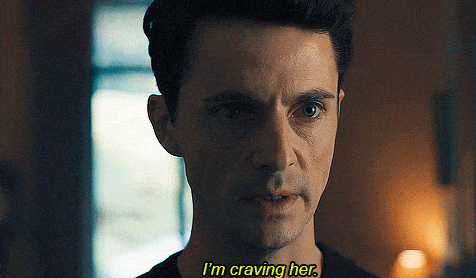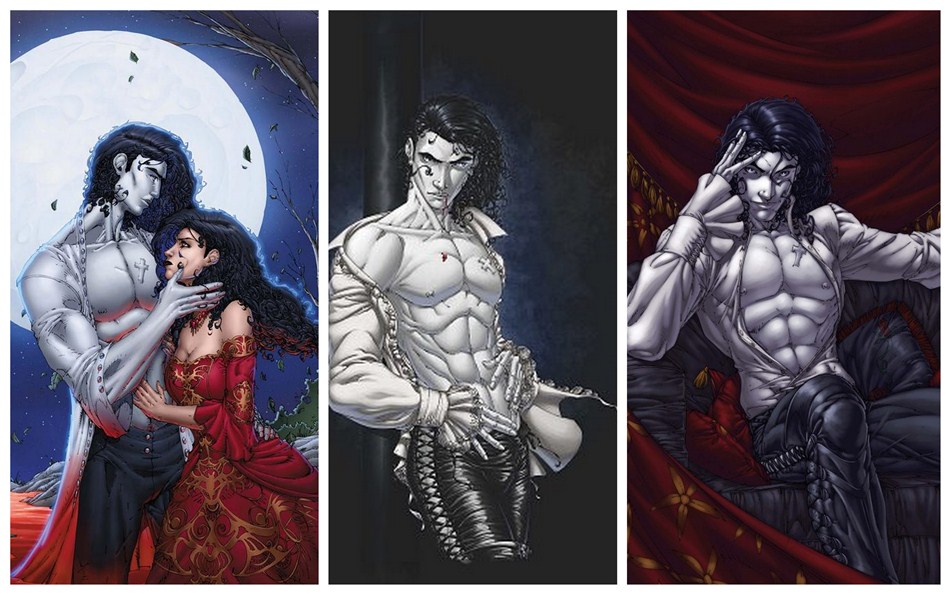
Twilight
Editor’s Note: content warning for violence, abuse, and potentially triggering subject matter.
What is seduction? Most people would define it as something pleasant. A series of actions and behaviors performed by someone they find attractive to make them even more alluring. However, if we examine the actual definition of seduction, it’s a bit more sinister than that. Merriam-Webster defines seduction as “the act or pressure of giving in to a desire especially when ill-advised.” Synonyms for seduce include: betray, bewitch, ensnare, and trap. To seduce someone is to break down their boundaries and entice them to do something, usually to engage in sexual activity, that they might not normally participate in.
In Part 1 of this series, I discussed stalking as a problematic aspect of romantic vampire fiction and compared this common behavior of vampires, particularly male vampires, toward their love interests with the behavior of serial killers stalking their victims. I dissected two of the most popular examples of romantic vampire fiction, Stephenie Meyer’s Twilight Saga and Deborah Harkness’s All Souls Trilogy, because they feature vampires that have become the modern ideal of romantic male leads — handsome, rich, powerful, and in most cases, white.
Even if your stalker is charming and handsome, there are obvious problems with having someone watching your every move. The act of stalking is extremely predatory and is a sign of worse things to come. For vampires, stalking is akin to hunting. In romantic vampire fiction, stalking is a sign that the vampire is interested in pursuing a relationship with the female protagonist. Vampires like Matthew Clairmont and Edward Cullen find it perfectly normal to climb through a woman’s window and watch her sleep without her knowledge or consent. Not only is this behavior considered romantic, but it is also viewed as a tactic for keeping the female protagonist safe while getting to know her.

A Discovery of Witches
Safe from what, you might ask. Ironically, other suitors. Vampires are not only predatory, but also exceedingly territorial when it comes to things that belong to them, including romantic partners. One of the notable exceptions to this rule are the vampires in Laurell K. Hamilton’s Anita Blake Vampire Hunter Series. Which is a great place to start a discussion of the use of seduction in vampire fiction.
In the first Anita Blake novel, Guilty Pleasures (1993), we are introduced to an extremely seductive French vampire, Jean-Claude, who owns a strip club where vampires and shapeshifters take off their clothes for a predominantly human audience. Initially, when Jean-Claude and Anita Blake meet, the sexually repressed vampire hunter rebuffs the advances made by the vampire. They form a mutually beneficial alliance to deal with more powerful vampires who pose a threat to the people of St. Louis, and their alliance evolves into one of the hottest romantic relationships in speculative fiction. What begins as a kissing-only love triangle between Anita, Jean-Claude, and werewolf Richard Zeeman, expands into a polyamorous relationship that includes an absurd number of supernatural partners that would make porn stars blush.

Anita Blake Vampire Hunter comic series, art by Brett Booth and Wellington Alves
Seduction is one of Jean-Claude’s vampire superpowers. Much like mind reading, flight, compulsion, and walking in daylight, this vampire’s sex appeal has supernatural elements that categorize him as more of an incubus than a vampire. It takes him three novels and a whole lot of flirting, sexual innuendo, and risking his own life to entice Anita into a sexual relationship, but eventually they become a couple. A couple who shares their bed with an ever-expanding roster of lovers, but a couple, nonetheless. Jean-Claude uses seduction to attract the lovers he wants, but he also uses it as a tool and weapon to manipulate people in his rise to power. Occasionally, he will use Anita for this same purpose. Their bond gave her similar abilities, and Jean-Claude is a master of manipulation, often using Anita’s and his own body and promises of mind-bending sex as bait to get what he wants.
Damon Salvatore of The Vampire Diaries uses seduction almost as often as he uses violence to accomplish his goals. And his primary goal is making Elena Gilbert fall in love with him. A skilled stalker and ruthless killer, Damon inserts himself into Elena Gilbert’s life and pursues her until she finally acknowledges her attraction to him. Damon isn’t into sharing Elena with anyone and can be quite possessive of her even though he isn’t exactly the poster boy for committed monogamous relationships. Throughout the first and second seasons of The Vampire Diaries, Damon uses charm, humor, promises of loyalty, raw animal magnetism, and even threats to persuade Elena to dump his brother Stefan and ignore any and all other men who might be interested in forming a lasting bond with her. Seduction seems to come naturally for Damon, and even though he is an antagonist, you can’t help rooting for him to win over Elena. He’s a very charming serial killer.

The Vampire Diaries
Unlike Jean-Claude and Damon who are very open about their sexuality and expressing their desires, Matthew Clairmont and Edward Cullen are much more careful about how they interact with their female love interests and have limited sexual contact with them. Matthew Clairmont and Diana Bishop kiss and have oral sex, but no intercourse until their wedding night despite Diana’s repeated efforts to fully consummate their relationship. Sex happens only when Matthew decides it is the right time and under the appropriate circumstances, which doesn’t occur until almost halfway through the second novel, Shadow of Night (2012). Edward Cullen is extremely repressed, and only allows Bella to kiss him until after they are on their honeymoon, which takes place in the fourth and final book of the series, Breaking Dawn (2008). Like Diana Bishop, Bella Swan is in touch with her sexuality and wants to engage in a sexual relationship with Edward who repeatedly rejects her advances.
Both Matthew and Edward warn their partners that sex with vampires is not only dangerous but represents a lasting bond that can only be broken when one or both dies. Matthew has a lot of guilt over previous relationships in which his partners died and the shocking number of murders he’s committed over the course of his very long life. He worries that Diana will reject him, so he controls every aspect of the sexual relationship until he is convinced she won’t leave him. Edward suffers from similar guilt and worries that his strong vampire body will crush Bella’s weak human body during sex. He isn’t wrong. After they make love for the first time, Bella is covered in bruises and the sight of them fill Edward with more guilt and revulsion. Beyond the basic cannibalistic nature of vampire romance (vampires drink human blood), there is quite a bit of body horror and violence woven into Bella Swan and Edward Cullen’s sexual relationship, from their honeymoon through Bella’s pregnancy. In chapter five (“Isle Esme”) of Breaking Dawn, they make love for the first time and Edward leaves evidence of their lovemaking on Bella’s body:
“…large purplish bruises were beginning to blossom across the pale skin of my arm. My eyes followed the trail they made up to my shoulder, and then down across my ribs. I pulled my hand free to poke at a discoloration on my left forearm, watching it fade where I touched and then reappear. It throbbed a little.
So lightly that he was barely touching me, Edward placed his hand against the bruises on my arm, one at a time, matching his long fingers to the patterns.” (p.89)
Edward feels so guilty after their first encounter that he refuses to have sex again, fearing that he will hurt Bella again. Until she becomes a vampire, Edward controls every aspect of their lovemaking and does everything in his power to convince Bella that sex is a terrible idea.

A Discovery of Witches
Much like wolves, these vampires mate for life and the rules of vampire courtship and mating requires a couple to consummate their relationship for other vampires to acknowledge their marriage. Not unlike regular human matrimony, except humans are now permitted to get divorced and no one is required to die if things don’t work out.
Matthew and Edward both profess their love rather quickly but refuse to satisfy their partners’ need for complete sexual intimacy. These mixed messages of being desired and rejected simultaneously create feelings of low self-esteem in Bella and Diana. Each woman questions their own value based on whether these vampires find them sexually attractive and are distracted from the fact that they should be afraid of the potential violence and death associated with having sex with monsters.

Twilight
Withholding sex is a textbook form of manipulation in abusive relationships that draws the victim in deeper as they try to prove their worthiness to their abuser. In short, Edward Cullen and Matthew Clairmont are narcissists who use sex and the promise of intimacy to entice their victims/lovers and then withhold sex as a form of controlling them. Typically, vampires are dangerous because they hunt people like animals and drink human blood. Edward and Matthew are more dangerous because they have perfected a calculated method of using seduction and rejection interchangeably to manipulate their partners into being addicted to their affection. An addiction that makes them irrationally willing to give up their own lives in order to have these monsters love them.
Rather than viewing this vampiric method of seduction as romantic, perhaps we should be reading romantic vampire fiction as cautionary tales. Stories to educate girls and young women about the dangers of being seduced into relationships with predatory monsters. Instead of using handsome vampires as a template for the perfect mate, we should be treating this subgenre like fairy tales. Not the cleaned up Disney versions, but the original Grimm Brothers and Charles Perrault tales that taught children not to wander off into the woods and talk to strangers. Strangers who tempt us off the path and seduce us to our deaths. In the immortal words of Angela Carter from her short story, “The Company of Wolves” (1979), “But the worst thing of all, my dearie, is – some wolves are hairy on the inside” (64). If we aren’t careful, we won’t see the monster until it is too late to run.
Featured image from Twilight: Eclipse.

[…] part 2 of this series that dealt with seduction, I posited that rather than viewing a vampire’s predatory behavior […]